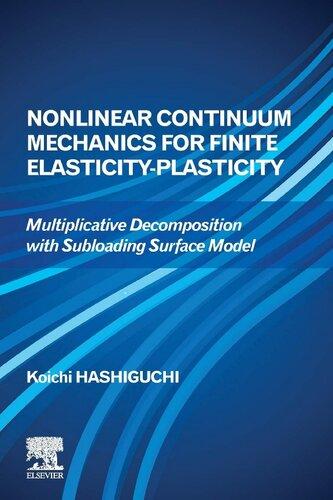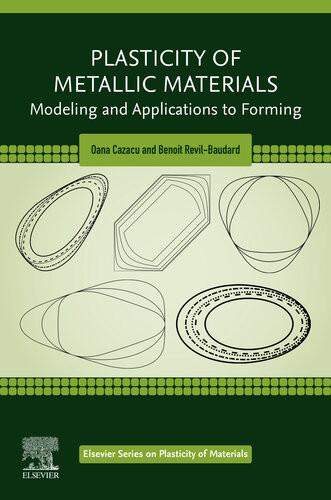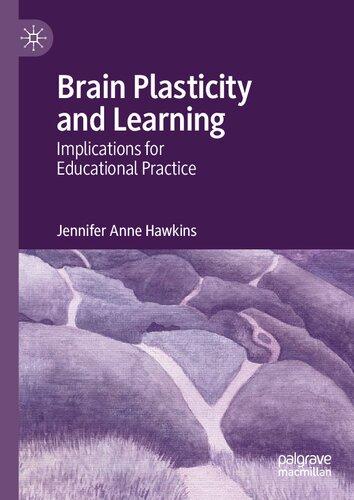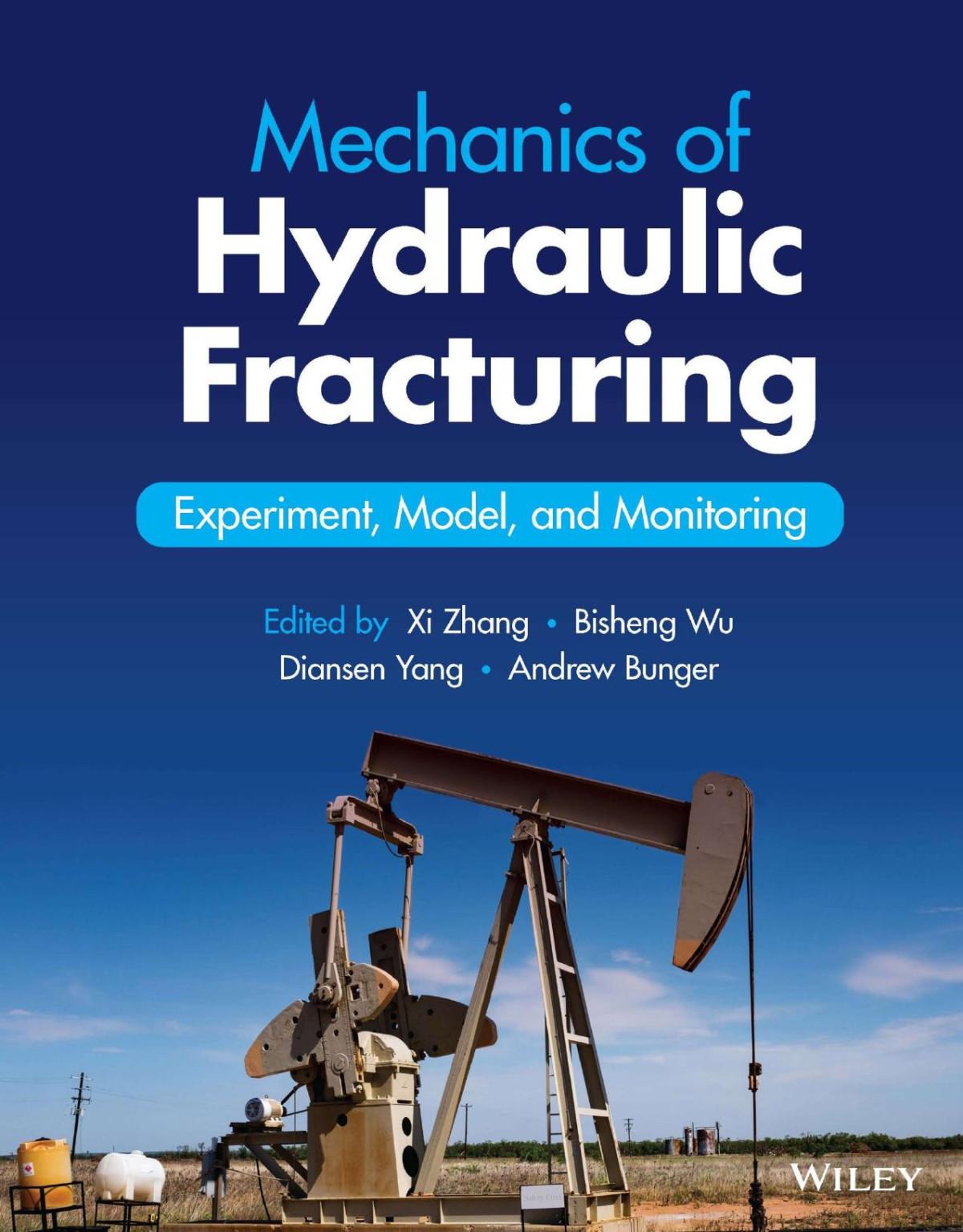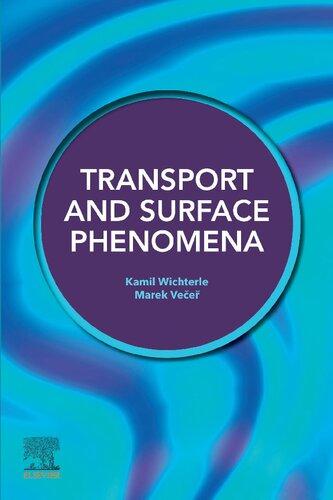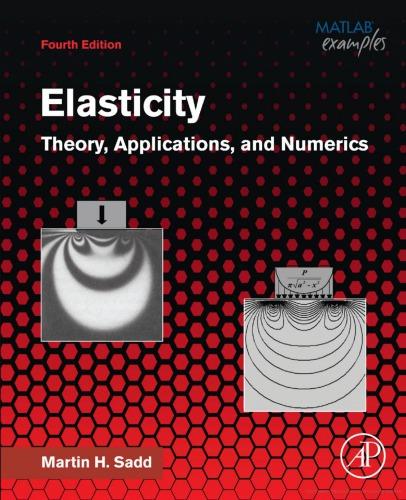NONLINEAR CONTINUUM MECHANICSFOR
MultiplicativeDecompositionWith
SubloadingSurfaceModel
KOICHI HASHIGUCHI TechnicalAdviser,MSCSoftwareLtd. (EmeritusProfessorofKyushuUniversity),
Tokyo,Japan
Elsevier
Radarweg29,POBox211,1000AEAmsterdam,Netherlands TheBoulevard,LangfordLane,Kidlington,OxfordOX51GB,UnitedKingdom 50HampshireStreet,5thFloor,Cambridge,MA02139,UnitedStates
Copyright©2020ElsevierInc.Allrightsreserved.
Nopartofthispublicationmaybereproducedortransmittedinanyformorbyanymeans, electronicormechanical,includingphotocopying,recording,oranyinformationstorageand retrievalsystem,withoutpermissioninwritingfromthepublisher.Detailsonhowtoseek permission,urtherinformationaboutthePublisher’spermissionspoliciesandourarrangements withorganizationssuchastheCopyrightClearanceCenterandtheCopyrightLicensingAgency, canbefoundatourwebsite: www.elsevier.com/permissions.
Thisbookandtheindividualcontributionscontainedinitareprotectedundercopyright bythePublisher(otherthanasmaybenotedherein).
Notices
Knowledgeandbestpracticeinthisfieldareconstantlychanging.Asnewresearchandexperience broadenourunderstanding,changesinresearchmethods,professionalpractices,ormedical treatmentmaybecomenecessary.
Practitionersandresearchersmustalwaysrelyontheirownexperienceandknowledgein evaluatingandusinganyinformation,methods,compounds,orexperimentsdescribedherein. Inusingsuchinformationormethodstheyshouldbemindfuloftheirownsafetyandthesafety ofothers,includingpartiesforwhomtheyhaveaprofessionalresponsibility.
Tothefullestextentofthelaw,neitherthePublishernortheauthors,contributors,oreditors, assumeanyliabilityforanyinjuryand/ordamagetopersonsorpropertyasamatterofproducts liability,negligenceorotherwise,orfromanyuseoroperationofanymethods,products, instructions,orideascontainedinthematerialherein.
BritishLibraryCataloguing-in-PublicationData
AcataloguerecordforthisbookisavailablefromtheBritishLibrary LibraryofCongressCataloging-in-PublicationData
AcatalogrecordforthisbookisavailablefromtheLibraryofCongress ISBN:978-0-12-819428-7
ForInformationonallElsevierpublications visitourwebsiteat https://www.elsevier.com/books-and-journals
Publisher: MatthewDeans
AcquisitionsEditor: DennisMcGonagle
EditorialProjectManager: JoshuaMearns
ProductionProjectManager: SojanP.Pazhayattil
CoverDesigner: GregHarris
TypesetbyMPSLimited,Chennai,India
Prefacexi
1. Mathematicalfundamentals1
1.1Matrixalgebra1
1.1.1Summationconvention1
1.1.2Kronecker’sdeltaandalternatingsymbol2
1.1.3Matrixnotationanddeterminant2
1.2Vector6
1.2.1Definitionofvector7
1.2.2Operationsofvector7
1.3Definitionoftensor15
1.4Tensoroperations18
1.4.1Propertiesofsecond-ordertensor18
1.4.2Tensorcomponents19
1.4.3Transposedtensor20
1.4.4Inversetensor21
1.4.5Orthogonaltensor22
1.4.6Tensordecompositions24
1.4.7Axialvector25
1.4.8Determinant27
1.4.9Simultaneousequationforvectorcomponents30
1.5Representationsoftensors31
1.5.1Notationsintensoroperations31
1.5.2Operationaltensors32
1.5.3Isotropictensors34
1.6Eigenvaluesandeigenvectors35
1.6.1Eigenvaluesandeigenvectorsofsecond-ordertensor35
1.6.2Spectralrepresentationandelementarytensorfunctions37
1.6.3Cayley Hamiltontheorem38
1.6.4Scalartripleproductswithinvariants39
1.6.5Second-ordertensorfunctions39
1.6.6Positive-definitetensorandpolardecomposition40
1.6.7Representationtheoremofisotropictensor-valuedtensorfunction42
1.7Differentialformulae43
1.7.1Partialderivativesoftensorfunctions43
1.7.2Time-derivativesinLagrangianandEuleriandescriptions48
1.7.3Derivativesoftensorfield49
1.7.4Gauss’divergencetheorem51
1.7.5Material-timederivativeofvolumeintegration52
1.8Variationsofgeometricalelements53
1.8.1Deformationgradientandvariationsofline,surfaceandvolume elements53
1.8.2Velocitygradientandratesofline,surfaceandvolumeelements56
2. Curvilinearcoordinatesystem61
2.1Primaryandreciprocalbasevectors61
2.2Metrictensorandbasevectoralgebra65
2.3Tensorrepresentations68
3. Tensoroperationsinconvectedcoordinatesystem77
3.1Advantagesofdescriptioninembeddedcoordinatesystem77
3.2Convectedbasevectors79
3.3Deformationgradienttensor80
3.4Pull-backandpush-forwardoperations83
3.5Convectedtime-derivative88
3.5.1Generalconvectedderivative89
3.5.2Corotationalrate92
3.5.3Objectivityofconvectedrate95
4. Deformation/rotation(rate)tensors101
4.1Deformationtensors101
4.2Straintensors106
4.2.1GreenandAlmansistraintensors106
4.2.2Generalstraintensors109
4.2.3Logarithmicstraintensor113
4.3Volumetricandisochoricpartsofdeformationgradienttensor114
4.4Strainrateandspintensors117
4.4.1Strainrateandspintensorsbasedonvelocitygradienttensor117
4.4.2Strainratetensorbasedongeneralstraintensor120
5. Conservationlawsandstresstensors123
5.1Conservationlaws123
5.1.1Conservationlawofphysicalquantity123
5.1.2Conservationlawofmass124
5.1.3Conservationlawoflinearmomentum125
5.1.4Conservationlawofangularmomentum126
5.2Cauchystresstensor127
5.2.1DefinitionofCauchystresstensor127
5.2.2SymmetryofCauchystresstensor130
5.3Balancelawsincurrentconfiguration132
5.3.1Translationalequilibrium133
5.3.2Rotationalequilibrium:symmetryofCauchystresstensor133
5.3.3Virtualworkprinciple134
5.3.4Conservationlawofenergy135
5.4Work-conjugacy135
5.4.1Kirchhoffstresstensorandwork-conjugacy136
5.4.2Work-conjugatepairs137
5.4.3Physicalmeaningsofstresstensors138
5.4.4Relationsofstresstensors141
5.4.5Relationsofstresstensorstotractionvectors142
5.5Balancelawsinreferenceconfiguration145
5.5.1Translationalequilibrium145
5.5.2Virtualworkprinciple146
5.5.3Conservationlawofenergy146
5.6Simpleshear147
6. Hyperelasticequations151
6.1Basichyperelasticequations151
6.2Hyperelasticconstitutiveequationsofmetals155
6.2.1St.Venant Kirchhoffelasticity155
6.2.2ModifiedSt.Venant Kirchhoffelasticity156
6.2.3Neo-Hookeanelasticity157
6.2.4Modifiedneo-Hookeanelasticity(1)157
6.2.5Modifiedneo-Hookeanelasticity(2)158
6.2.6Modifiedneo-Hookeanelasticity(3)158
6.2.7Modifiedneo-Hookeanelasticity(4)159
6.3Hyperelasticequationsofrubbers159
6.4Hyperelasticequationsofsoils160
6.5Hyperelasticityininfinitesimalstrain161
7. Developmentofelastoplasticandviscoplasticconstitutive equations163
7.1Basisofelastoplasticconstitutiveequations163
7.1.1Fundamentalrequirementsforelastoplasticity164
7.1.2Requirementsforelastoplasticconstitutiveequation166
7.2Historicaldevelopmentofelastoplasticconstitutiveequations168
7.2.1Infinitesimalhyperelastic-basedplasticity168
7.2.2Hypoelastic-basedplasticity178
7.2.3Multiplicativehyperelastic-basedplasticity181
7.3Subloadingsurfacemodel182
7.4Cyclicplasticitymodels188
7.4.1Cyclickinematichardeningmodelswithyieldsurface188
7.4.2AdhocChabochemodelandOhno-Wangmodelexcludingyield surface191
7.4.3Extendedsubloadingsurfacemodel192
7.5Formulationof(extended)subloadingsurfacemodel195
7.5.1Normal-yieldandsubloadingsurfaces195
7.5.2Evolutionruleofelastic-core198
7.5.3Plasticstrainrate205
7.5.4Strainrateversusstressraterelations206
7.5.5Calculationofnormal-yieldratio207
7.5.6Improvementofinverseandreloadingresponses208
7.5.7Cyclicstagnationofisotropichardening209
7.6Implicittime-integration:return-mapping213
7.6.1Return-mappingformulation213
7.6.2Loadingcriterion221
7.6.3Initialvalueofnormal-yieldratioinplasticcorrectorstep224
7.6.4Consistenttangentmodulustensor227
7.7Subloading-overstressmodel229
7.7.1Constitutiveequation230
7.7.2Defectsofpastoverstressmodel238
7.7.3Onirrationalityofcreepmodel240
7.7.4Implicitstressintegration243
7.7.5Temperaturedependenceofisotropichardeningfunction249
7.8Fundamentalcharacteristicsofsubloadingsurfacemodel249
7.8.1Distinguishedabilitiesofsubloadingsurfacemodel250
7.8.2Boundingsurfacemodelwithradial-mapping:Misuseofsubloading surfacemodel252
8. Multiplicativedecompositionofdeformationgradienttensor255
8.1Elastic-plasticdecompositionofdeformationmeasure256
8.1.1Necessityofmultiplicativedecompositionofdeformationgradient tensor256
8.1.2Isoclinicconcept259
8.1.3Uniquenessofmultiplicativedecomposition262
8.1.4Embeddedbasevectorsinintermediateconfiguration263
8.2Deformationtensors264
8.2.1ElasticandplasticrightCauchy-Greendeformationtensor264
8.2.2Strainrateandspintensors265
8.3Onlimitationofhypoelastic-basedplasticity269
8.4Multiplicativedecompositionforkinematichardening271
9. Subloading-multiplicativehyperelastic-basedplasticand viscoplasticconstitutiveequations273
9.1Stressmeasures273
9.2Hyperelasticconstitutiveequations275
9.3Conventionalelastoplasticmodel277
9.3.1Flowrulesforplasticstrainrateandplasticspin277
9.3.2Confirmationforuniquenessofmultiplicativedecomposition281
9.3.3Plasticstrainrate281
9.4Continuityandsmoothnessconditions283
9.5Initialsubloadingsurfacemodel284
9.6Multiplicativeextendedsubloadingsurfacemodel286
9.6.1Multiplicativedecompositionofplasticdeformationgradientfor elastic-core286
9.6.2Normal-yield,subloadingandelastic-coresurfaces289
9.6.3Plasticflowrules291
9.6.4Plasticstrainrate294
9.7Materialfunctionsofmetalsandsoils296
9.7.1Metals296
9.7.2Soils300
9.8Calculationprocedure306
9.9Implicitcalculationbyreturn-mapping309
9.9.1Return-mapping309
9.9.2Loadingcriterion312
9.9.3Initialvalueofnormal-yieldratioinplasticcorrectorstep314
9.10Cyclicstagnationofisotropichardening317
9.11Multiplicativesubloading-overstressmodel320
9.11.1Constitutiveequation320
9.11.2Calculationprocedure326
9.11.3Implicitcalculationbyreturn-mapping328
9.12Onmultiplicativehyperelastic-basedplasticequationincurrent configuration330
10. Subloading-frictionmodel:finiteslidingtheory335
10.1Historyoffrictionmodels335
10.2Slidingdisplacementandcontacttractionvectors336
10.3Hyperelasticslidingdisplacement339
10.4Normal-slidingandsubloading-slidingsurfaces340
10.5Evolutionruleoffrictioncoefficient341
10.6Evolutionruleofslidingnormal-yieldratio342
10.7Plasticslidingvelocity344
10.8Calculationprocedure348
10.9Return-mapping349
10.9.1Return-mappingformulation349
10.9.2Loadingcriterion353
10.10Subloading-overstressfrictionmodel356
10.11Implicitstressintegration362
10.12Oncruciallyimportantapplicationsofsubloading-frictionmodel363
10.12.1Looseningofscrew363
10.12.2Deterministicpredictionofearthquakeoccurrence364
11. Commentsonformulationsforirreversiblemechanical phenomena365
11.1Utilizationofsubloadingsurfacemodel365
11.1.1Mechanicalphenomenadescribedbysubloadingsurfacemodel365 11.1.2Standardinstallationtocommercialsoftware367
11.2Disusesofrate-independentelastoplasticconstitutiveequations368
11.3Impertinenceofformulationofplasticflowrulebasedonsecondlawof thermodynamics369
Appendix1:Proofsforformulaofscalartripleproducts withinvariants371
Appendix2:Convectivestressratetensors373
Appendix3:Cauchyelasticandhypoelasticequations377 Bibliography379 Index393 x CONTENTS
Preface
Theelastoplasticitytheoryisnowfacedtotheepoch-makingdevelopmentthattheexactdescriptionofthefiniteirreversible(plasticorviscoplastic)deformation/slidingbehaviorunderthemonotonic/cyclic loadinginthegeneralrateofdeformation/slidingfromthestatictothe impactloadingisattainedasthe subloadingmultiplicativehyperelastic basedplasticity and viscoplasticity.Thisisthefirstbookonthistheory,comprehensivelydescribingtheunderlyingconceptsandthe formulationsforthe subloadingsurfacemodel andforthe multiplicative decompositionofdeformationgradienttensor intotheelasticandtheplastic (orviscoplastic)partsandtheircombination.
Theprecisedescriptionoftheplasticstrainrateinducedbytherate ofstressinsidetheyieldsurfaceisinevitableforthepredictionofcyclic loadingbehavior,whichiscrucialfortheaccuratemechanicaldesignof solidsandstructuresinengineering.Alotofworkshavebeenexecuted andvarious unconventionalplasticconstitutive (cyclicplasticity) models, namedbyDrucker(1998),havebeenproposedaimingatdescribingthe plasticstrainratecausedbytherateofstressinsidetheyieldsurface after1960swhenthedemandsofmechanicaldesignsofsolidsand structuresforthemechanicalvibrationandtheseismicvibrationshave beenhighlyraisedrespondingtothehighdevelopmentofmachine industriesandthefrequentoccurrencesofearthquakes,e.g.Chile(1960) andNiigata(Japan)(1964).Amongvariousunconventionalmodelsthe multisurfacemodel(Mroz,1967;Iwan,1967),thetwosurfacemodel (DafaliasandPopov,1975;Krieg,1975;YoshidaandUemori,2002),and thesuperposed-kinematichardeningmodel(Chabocheetal.,1979; OhnoandWang,1993)arewellknown.However,theyassumeasurfaceenclosingapurelyelasticdomainandarebasedonthepremise thattheplasticstrainratedevelopswiththetranslationofthesmall yieldsurfacesothattheyarecalledthe cyclickinematichardeningmodel. Thereforetheypossessvariousdefects,forexample,(1)theabrupttransitionfromtheelastictotheplasticstateviolatingthecontinuityand thesmoothnessconditions(Hashiguchi,1993a,b,1997,2000),(2)the incorporationoftheoffsetvalueoftheplasticstrainatyield,whichis accompaniedwiththeunrealityandthearbitrariness,(3)theincapabilityofcyclicloadingbehaviorforthestressamplitudelessthanthesmall
surfaceenclosinganelasticdomain,(4)theincapabilityofthenonproportionalloadingbehavior,(5)theincapabilityofextensiontotheratedependencyathighrateofdeformationuptotheimpactloadingbehavior,(6)thelimitationtothedescriptionofdeformationbehaviorin metals,and(7)thenecessityoftheadditionalcumbersomeoperationto pullbackthestresstotheyieldsurfaceorthesmallsurfaceenclosingan elasticdomain.Inparticular,itisquitepitifulfromthescientificpoint ofviewthatthesuperposedcyclicplasticitymodel,i.e.theChaboche modelandtheOhno-Wangmodelarediffusedwidely,whicharethe mostprimitive adhoc cyclicplasticitymodelsignoringthehistorical developmentoftheplasticitybutregressingtotheeasygoingwayby theempiricalmethodaswillbeexplainedinSection7.4.
Now,itshouldbenotedthattheplasticstrainrateisnotinduced abruptlybutdevelopsgraduallyasthestressapproachestheyieldsurface.Infact,themutualslipsofmaterialparticles,forexample,crystal particlesinmetalsandsoilparticlesinsandsandclaysleadingtothe plasticdeformationisnotinducedsimultaneouslybutinducedgraduallyfrompartsinwhichmutualslipscanbeinducedeasily,exhibiting thesmoothtransitionfromtheelastictotheplastictransition.The subloadingsurfacemodel (Hashiguchi,1978,1980,1989,2017a;Hashiguchi andUeno,1997)isfreefromtheexistenceofthestressregionenclosing thepurelyelasticdomain,whiletheexistencehasbeenpostulatedin theotherelastoplasticitymodels.The subloadingsurface,whichpasses throughthecurrentstressandissimilartotheyieldsurface,isassumed insidetheyieldsurface,andthenitispostulatedthattheplasticstrain rateisnotinducedsuddenlyatthemomentwhenthestressreachesthe yieldsurfacebutitdevelopsasthestressapproachestheyieldsurface, thatis,asthesubloadingsurfaceexpands.Thereforethesmoothtransitionfromtheelastictotheplasticstate,thatis,the smoothelastic-plastic transition leadingtothecontinuousvariationofthetangentstiffness modulustensorisdescribedinthismodel.Thesubloadingsurface modelhasbeenappliedtothedescriptionsoftheelastoplasticdeformationbehaviorsofvarioussolids,forexample,metals,soils,concrete,etc. Further,ithasbeenextendedtodescribetheviscoplasticdeformation byincorporatingtheconceptoftheoverstress.Thesubloadingsurface modelwouldberegardedtobethe governinglawoftheirreversible mechanicalphenomenaofsolids
Thesubloadingsurfacemodelhasbeenincorporatedintothecommercialsoftware“Marc”inMSCSoftwareCorporationasthestandard installationbythename“Hashiguchimodel,”whichcanbeusedbyall Marcusers(contractors)sinceOctober,2017.Thereforeitisexplainedin theMarcusermanual(MSCSoftwareCorporation,2017)inbrief. Further,thefunctionfortheautomaticdeterminationofmaterialparameterswasinstalledintotheMarcasthestandardfunctioninJune
2019.Furthermore,thesubloading-frictionmodelwillalsobeincorporatedintotheMarcasthestandardinstallationuntiltheendof2020.
Themechanismsoftheelasticdeformationandtheplasticdeformationinthesolidsconsistingofmaterialparticlesarephysicallydifferent fromeachothersuchthattheformerisinducedbythedeformationof materialparticlesthemselves(e.g.,crystalparticlesinmetalsandsoil particlesinsandsandclays)butthelatterisinducedbythemutual slipsbetweenthematerialparticles.Further,notethatallthedeformationmeasures,forexample,theinfinitesimalandthefinite-straintensors andthestrainratetensor(skew-symmetricpartofvelocitygradienttensor)aredefinedbythedeformationgradienttensor.Thereforetheexact descriptionoffiniteelastoplasticdeformationrequirestheexactdecompositionofthedeformationgradienttensorintotheelasticandtheplasticparts.Furthermore,notethatthedeformationgradienttensoris definedbytheratio(note:notdifference)ofthecurrentinfinitesimal lineelementvectortotheinitialone.Then,themultiplicativedecompositionofthedeformationgradienttensorhasbeenintroducedforthe exactdescriptionoffiniteelastoplasticdeformationbytheleadingscholars(Kroner,1960;LeeandLiu,1967;Lee,1969;Mandel,1971,1972, 1973a;Kratochvil,1973).However,itnowpassedalreadymorethana halfcenturyafterthepropositionofthemultiplicativedecompositionof deformationgradienttensor.Inthemeantime,unfortunatelythe hypoelastic-basedplasticityhasbeenstudiedenthusiasticallybynumerousworkersrepresentedbyRodneyHillandJamesR.Riceafterthe propositionofthehypoelasticitybyTruesdell(1955),whichisnotbased onthemultiplicativedecompositionsothatitislimitedtotheinfinitesimalelasticdeformationandaccompaniedwiththecumbersometimeintegrationprocedureofthecorotationalratesofthestressandtensorvaluedinternalvariables.Inaddition,theconceptofthemultiplicative decompositionhasnotbeendelineatedproperlyeveninthe notablebooksreferringtothisconcept(cf.Lubliner,1990;Simo,1998; SimoandHughes,1998;Lubarda,2002;Haupt,2002;Nemat-Nasser, 2004;AsaroandLubarda,2006;BonetandWood,2008;deSauzaNeto etal.,2008;Gurtinetal.,2010;HashiguchiandYamakawa,2012; Belytshkoetal.,2014,etc.).
Themultiplicativehyperelastic basedplasticityhasbeenstudied centrallybySimoandhiscolleagues(e.g.,Simo,1985,1988a,b,1992; SimoandOrtiz,1985)inthelastcentury,inwhichthelogarithmicstrain hasbeenusedmainlyleadingtothecoaxialityofstressandstrainrate sothatithasbeenlimitedtotheisotropy.Ithasbeendevelopedactively fromthebeginningofthiscenturybyLion(2000),Menzeland Steinmann(2003a,b),Wallinetal.(2003),DettmerandReese(2004), Menzeletal.(2005),WallinandRistinmaa(2005),GurtinandAnand (2005),Sansouretal.(2006,2007),Vladimirovetal.(2008,2010),
HenannandAnand(2009),Brepolsetal.(2014),etc.,inwhichconstitutiverelationsareformulatedintheintermediateconfigurationimagined fictitiouslybytheunloadingtothestress-freestatealongthehyperelasticrelation,basedonthe isoclinicconcept (Mandel,1971).However,the plasticflowrulewiththegeneralityunlimitedtotheelasticisotropy remainsunsolvedandonlythe conventionalplasticitymodel,namedby Drucker(1998),withtheyieldsurfaceenclosingtheelasticdomainhave beenincorporatedsothatonlythemonotonicloadingbehaviorofelasticallyisotropicmaterialsisconcernedinthem.
Thesubloadingmultiplicativehyperelastic basedplasticmodelhas beenformulatedbytheauthorrecently(Hashiguchi,2018c),whichis capableofdescribingthefiniteelastoplasticdeformation/rotationrigorouslyunderthemonotonic/cyclicloadingprocess.Further,ithasbeen extendedtothesubloading-multiplicativehyperelastic-basedviscoplasticityrecently,whichiscapableofdescribingtherate-dependentelastoplasticdeformationbehavioratthegeneralratefromthestatictothe impactloading.Itistobethebestopportunitytoreviewthemultiplicativehyperelastic basedplasticitycomprehensivelyandexplainthe detailedformulationofthesubloadingmultiplicativehyperelastic basedplasticmodelsystematically.Thisisthefirstbookonthesubloadingmultiplicativehyperelastic basedplasticityandviscoplasticity forthedescriptionofthegeneralirreversibledeformation/sliding behavior.
Thesubloadingsurfacemodelandthemultiplicativehyperelastic basedplasticityareexplainedcomprehensivelyprovidingthe detailedphysicalinterpretationsforallrelevantconceptsandthederivingprocessesofallequations.Further,theincorporationofthesubloadingsurfacemodeltothemultiplicativehyperelasticplasticrelationis describedindetail.Further,itisextendedtothedescriptionoftheviscoplasticdeformationbyincorporatingtheconceptofoverstress,which iscapableofdescribingthegeneralrateofdeformationrangingfrom thequasistatictotheimpactloadingbehaviors(Hashiguchi,2016a, 2017a).Inaddition,theexacthyperelastic basedplasticandviscoplastic constitutiveequationoffriction(Hashiguchi,2018c)isformulatedrigorously,whilethehypoelastic-basedplasticconstitutiveequationoffrictionhasbeenformulatedformerly(Hashiguchietal.,2005;Hashiguchi andOzaki,2008;Hashiguchi,2013a).
Theaimofthisbookistogiveacomprehensiveexplanationofthe finiteelastoplasticitytheoryandviscoplasticityunderthemonotonic andthecyclicloadingprocesses.TheincorporationoftheLagrangian tensorsisrequiredoriginallyintheformulationoffiniteelastoplasticity andviscoplasticity,sincethedeformationofthematerialinvolvedin thereferenceconfiguration,whichisinvariantthroughthedeformation, isphysicallyrelevant.Thereforethenecessityandthemeaningsofthe
LagrangiantensorsandthetransformationsrulesbetweentheEulerian andtheLagrangiantensors,thatis,thepull-backandpush-forward operationsareexplainedconcisely.VariousLagrangianstresstensors arederivedbasedontherequirementofthework-conjugacyfromthe Cauchystresstensorinthecurrentconfiguration.Tothisend,the descriptionsofphysicalquantitiesandrelationsintheembedded(convected)coordinatesystem,whichturnsintothecurvilinearcoordinate systemunderthedeformationofmaterial,arerequired,sincetheir physicalmeaningscanbecapturedclearlybyobservingtheminthe coordinatesystemthatnotonlymovesbutalsodeformsandrotates withmaterialitself.Inotherwords,theessentialsofcontinuummechanicscannotbecapturedwithouttheincorporationofthegeneralcurvilinearcoordinatesystem,towhichtheembeddedcoordinatesystem changes,althoughtheexplanationonlyintherectangularcoordinate systemisgiveninalotofbooksentitled“continuummechanics.”
Theauthorexpectsthatthereadersofthisbookwillcapturethefundamentalsinthefinite-strainelastoplasticitytheoryandtheywillcontributetothedevelopmentofmechanicaldesignsofmachineryand structuresinthefieldofengineeringpracticebyapplyingthetheories addressedinthisbook.Areaderisapttogiveupreadingthrougha bookifoneencountersamatterthatisuneasytounderstandbyinsufficientexplanation.Forthisreason,thedetailedexplanationsofphysical conceptsinelastoplasticityaredelineated,andthederivations/transformationprocessesofallequationsaregivenwithdetailedproofsbut withoutabbreviation.
Theauthorwishestoexpresscordialthankstohiscolleaguesat KyushuUniversity,whohavediscussedandcollaboratedoverseveral decades:Prof.M.Ueno(currentlyEmeritusProfessoratUniversityof theRyukyus)inparticular,andDr.T.Okayasu(currentlyAssociate ProfessoratKyushuUniversity),Dr.S.Tsutsumi(currentlyAssociate ProfessoratOsakaUniversity),Dr.T.OzakiofKyushuElectricEng. Consult.Inc.,Dr.S.Ozaki(currentlyAssociateProfessoratYokohama NationalUniversity),andDr.T.MaseofTokyoElectricPowerServices Co.,Ltd.(currentlyProfessorofTezukayamaGakuinUniv.)
Furthermore,theauthoristhankfultoDr.K.Okamura,Dr.N. Suzuki,andDr.R.Higuchi,NipponSteel&SumitomoMetal Corporation,Dr.M.OkaandMr.T.Anjiki,YanmarCo.Ltd.,forthecollaborationsonconstitutiverelationsofmetalsandthenumericalcalculations.Inparticular,thenumericalcalculationsperformedbyMr.T. Anjikiwasquiteeffectivefortheimprovementofthesubloadingoverstressmodel.TheauthorisalsogratefultoMr.T.Kato(President) andDr.M.Tateishi(Fellow),MSCSoftware,Ltd.,Japanforthestandard implementationoftheHashiguchi(subloadingsurface)modeltothe commercialFEM(FiniteElementMethod)software Marc.
Another random document with no related content on Scribd:
If the second copy is also defective, you may demand a refund in writing without further opportunities to fix the problem.
1.F.4. Except for the limited right of replacement or refund set forth in paragraph 1.F.3, this work is provided to you ‘AS-IS’, WITH NO OTHER WARRANTIES OF ANY KIND, EXPRESS OR IMPLIED, INCLUDING BUT NOT LIMITED TO WARRANTIES OF MERCHANTABILITY OR FITNESS FOR ANY PURPOSE.
1.F.5. Some states do not allow disclaimers of certain implied warranties or the exclusion or limitation of certain types of damages. If any disclaimer or limitation set forth in this agreement violates the law of the state applicable to this agreement, the agreement shall be interpreted to make the maximum disclaimer or limitation permitted by the applicable state law. The invalidity or unenforceability of any provision of this agreement shall not void the remaining provisions.
1.F.6. INDEMNITY - You agree to indemnify and hold the Foundation, the trademark owner, any agent or employee of the Foundation, anyone providing copies of Project Gutenberg™ electronic works in accordance with this agreement, and any volunteers associated with the production, promotion and distribution of Project Gutenberg™ electronic works, harmless from all liability, costs and expenses, including legal fees, that arise directly or indirectly from any of the following which you do or cause to occur: (a) distribution of this or any Project Gutenberg™ work, (b) alteration, modification, or additions or deletions to any Project Gutenberg™ work, and (c) any Defect you cause.
Section 2. Information about the Mission of
Project Gutenberg™ is synonymous with the free distribution of electronic works in formats readable by the widest variety of computers including obsolete, old, middle-aged and new computers. It exists because of the efforts of hundreds of volunteers and donations from people in all walks of life.
Volunteers and financial support to provide volunteers with the assistance they need are critical to reaching Project Gutenberg™’s goals and ensuring that the Project Gutenberg™ collection will remain freely available for generations to come. In 2001, the Project Gutenberg Literary Archive Foundation was created to provide a secure and permanent future for Project Gutenberg™ and future generations. To learn more about the Project Gutenberg Literary Archive Foundation and how your efforts and donations can help, see Sections 3 and 4 and the Foundation information page at www.gutenberg.org.
Section 3. Information about the Project
